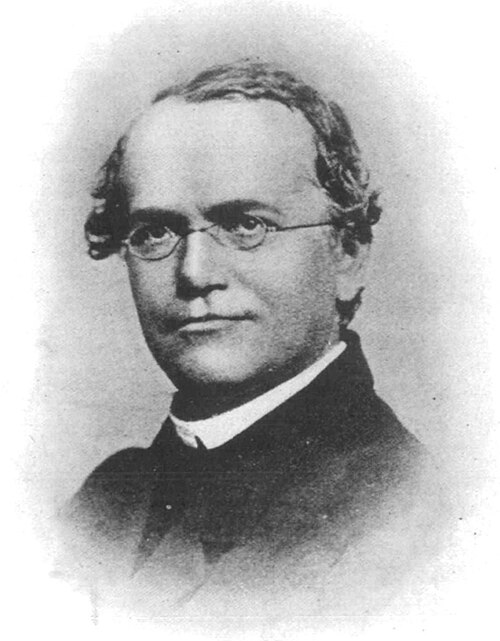
Timelines 10
Man and his Senses 10
Man and his Inventions 10
Geography 10
Fauna 10
Timelines 10
Man and his Senses 10
Man and his Inventions 10
Geography 10
Fauna 10

In the middle decades of the 19th century, the monastery garden at Brno became a proving ground for a new science when Gregor Johann Mendel’s pea crosses revealed that discrete hereditary “factors” segregate and recombine in consistent ratios across generations. Working from 1856 to 1863, Mendel’s careful counts uncovered dominance and recessiveness as recurrent patterns, establishing a framework that would later be recognized as a cornerstone of genetics and inheritance in plants. Although his work was not immediately embraced, the clarity of the ratios and the replicability of his experiments eventually anchored modern understandings of how traits pass in controlled crosses, especially in botanical systems.
Mendel’s laws—segregation and independent assortment—provided a grammar for heredity, showing that complex phenotypes could be decomposed into predictable units that follow rule-like behavior when confounding factors are minimized.
These principles helped generations of plant biologists and breeders connect observable traits to underlying hereditary units, guiding experimental design and interpretation across a wide range of species. By formalizing the relationship between parental contributions and offspring outcomes, Mendelian analysis transformed plant breeding from artisanal practice into hypothesis-driven science.
At the same time, genetics evolved by documenting cases that extend beyond simple Mendelian ratios, such as incomplete dominance, codominance, linkage, pleiotropy, and other departures that appear in more complex settings.
Rather than overturning Mendel, these exceptions enrich the picture by mapping when and why the original rules shift as traits interact, environments vary, or chromosomes fail to assort independently, especially outside simplified crossing schemes. In modern plant science, this duality—clean patterns in controlled crosses alongside well-characterized exceptions—remains fundamental to how trait inheritance is modelled and tested.
Beyond simple laws
The enduring value of Mendel’s contribution is twofold: it offers a parsimonious starting point for analyzing heredity and a benchmark against which non-Mendelian patterns can be measured and explained in realistic plant populations. This combination of rule and refinement allows researchers to move from idealized cases toward the nuanced inheritance seen in breeding programs, field trials, and natural variation.
In practice, Mendelian reasoning provides the scaffolding for crossing designs, segregation analyses, and trait mapping, while the catalogue of exceptions alerts researchers to the mechanisms that complicate those expectations. Together, they keep plant heredity intelligible and testable, even as traits become quantitative, environments fluctuate, and genetic backgrounds introduce interaction effects.
Indian parallel: J. C. Bose on plant responses
Running parallel to Mendel’s heredity in plants is the Indian tradition exemplified by Jagadish Chandra Bose, who devised exquisitely sensitive instruments and experiments to record minute plant responses and thereby demonstrate that plants are living systems with measurable physiological activity. Bose’s work drew public attention by showing that plants register stimuli through subtle changes that can be recorded and analyzed, challenging complacent views of plants as passive and highlighting their dynamic responsiveness. These demonstrations positioned plant physiology—especially sensitivity to external conditions—as a complementary lens to heredity for understanding the life of plants.
Central to Bose’s approach was instrument-making that could capture infinitesimal growth and response movements, converting the nearly imperceptible into tracings and records that spoke about plant vitality. By subjecting plants to variations in temperature, chemicals, and other stimuli, he documented distinct patterns of response that emphasized the continuity of physiological principles across living systems. The persuasive power of these records lay in their ability to turn small, slow signals into intelligible evidence of plant sensation and reactivity.
Public accounts of Bose’s work often underscore how his demonstrations popularized the idea that plants exhibit fatigue, excitation, and stress responses that can be measured, shifting popular and scientific discourse about plant life.
This narrative—of recorded plant “signatures” under different stimuli—helped inspire a broader recognition that the vegetal world presents detectable patterns of behavior when supplied with the right instruments. As a result, plant physiology gained a vivid public profile in India and beyond, reinforcing the scientific claim that plants’ internal processes can be made visible through precise measurement.
Later retellings and tributes have continued to frame Bose as a pioneer who proved that plants have life in measurable, demonstrable ways, highlighting his role as a public communicator of science as much as a laboratory innovator. These narratives emphasize that the measured traces of plant motion and responsiveness constitute scientific evidence of vitality rather than metaphor, inviting readers to see plants as active and responsive beings. In this way, Bose’s legacy offers a striking complement to the heredity-first tradition by foregrounding how living plants register the world they inhabit through quantifiable signals.

Connecting heredity and physiology
Set beside Mendel’s rules, Bose’s records of plant sensitivity provide a two-angle view of plant life: heredity reveals how traits are transmitted, while physiology reveals how living plants sense and respond to stimuli over time. The shared implication is that plant biology can be made legible through designed experiments and careful measurement—counting peas in crosses or tracing growth responses with sensitive apparatus. Each tradition isolates a dimension of the same living system, inviting synthesis across genetics and physiology for a richer explanatory framework.
In teaching and communication, pairing Mendel and Bose clarifies that understanding plants requires both the logic of transmission and the evidence of sensation, both abstract regularities and concrete traces. This pairing also provides a way to anchor public narratives of plant science in two accessible images: the pea plots and tally sheets in a monastery garden, and the delicate instruments that turn slow growth into visible signatures. Taken together, they show how modest, well-crafted experiments can yield transformative insights when they convert hidden processes into patterns that can be read and replicated.
Taking Mendel’s laws for plant heredity and Bose’s measurements of plant responsiveness together, respects the distinctiveness of plant systems while showcasing two historic contributions that made plant life interpretable through rigorous, repeatable methods. It also recovers a balanced geography of science, acknowledging a European origin point for classical heredity and an Indian tradition that rendered plant sensitivity empirically legible.
Within this framing, Mendel supplies the conceptual structure that predicts how traits distribute across generations, and Bose supplies the empirical demonstration that plants register and transduce stimuli in ways that can be recorded and analyzed. Both achievements rely on simple yet ingenious experimental designs that disciplined observation into evidence, turning everyday materials—garden plots or handcrafted instruments—into engines of discovery.
Indo–Czech synthesis
An Indo–Czech synthesis emerges when Mendelian heredity is read alongside Bose’s plant electrophysiology: one shows how traits are inherited, the other how plants respond in real time, together mapping the transmission and expression of plant life. This synthesis honors the Czech contribution to heredity and the Indian contribution to measurable plant responsiveness, demonstrating that understanding plants requires both a theory of inheritance and a practice of detection. What this pairing ultimately offers is a way to tell a complete story of plants: from the invisible logic that shuttles traits between generations to the subtle signals that register stress, stimulus, and growth in living tissues. In both Brno and colonial Calcutta, small tools and patient observation made hidden processes visible, establishing a durable template for how plant science proceeds—from clarity in rules to clarity in records. That is the spirit this article preserves: a plant-first narrative linking heredity and physiology across Czech and Indian milestones
Sources:
https://tinyurl.com/22pjq8sb
https://tinyurl.com/27x4l6c5
https://tinyurl.com/2cnlpqwc
https://tinyurl.com/27z8blyl
https://tinyurl.com/2c9w734p
https://tinyurl.com/pcqylyj
https://tinyurl.com/yckzb2ej
https://tinyurl.com/23gfkxmb
https://tinyurl.com/yssrke34
https://tinyurl.com/3ubnas64
https://tinyurl.com/bdfz7n86